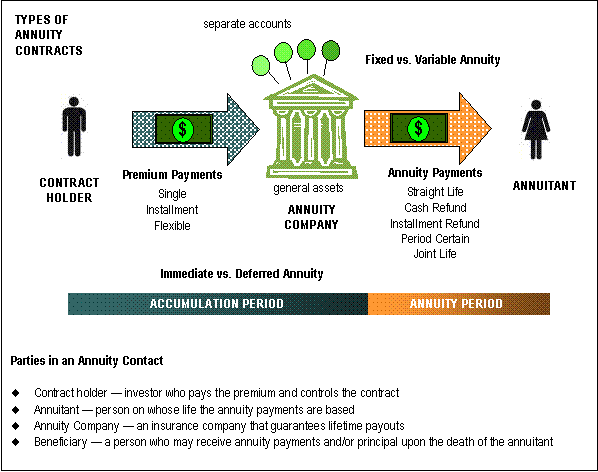

|
Primer Contents:
Structure & Design of Contracts investment configuration: fixed, variable, equity indexed Option Variable Annuity Riders: death benefits, lifetime benefits
The Nature of Annuities
An annuity is a stream of periodic payments. Start with a lump sum of money, pay it out in equal installments over a period of time until the original fund is exhausted, and you have created an annuity. An annuity is simply a vehicle for liquidating a sum of money. Of course, in practice the concept is more complex. An important factor not mentioned above is interest. The sum of money that has not yet been paid out is earning interest, and that interest will eventually pass on to the recipient.
Anyone can provide an annuity. Insurance companies provide lifetime annuities to retirees. A homebuyer will provide a mortgage company with an annuity as she pays off the monthly mortgage payments; likewise those purchasing cars and other goods on an installment plan are in effect paying out an annuity. By knowing the original sum of money (the principal), the length of the payout period and an assumed rate of interest, it is a fairly simple process to calculate the payment amount. Actuaries have constructed tables of annuity factors that make this process even easier. These tables are referred to as "present value interest factor for a $1 annuity". |
|
Years |
7% |
7.5% |
8% |
8.5% |
|
1 |
$0.934579 |
$0.930233 |
$0.925926 |
$0.921659 |
|
2 |
$1.808018 |
$1.795565 |
$1.783265 |
$1.771114 |
|
3 |
$2.624316 |
$2.600526 |
$2.577097 |
$2.554022 |
|
4 |
$3.387211 |
$3.349326 |
$3.312127 |
$3.275597 |
|
5 |
$4.100197 |
$4.045885 |
$3.992710 |
$3.940642 |
|
6 |
$4.766540 |
$4.693846 |
$4.622880 |
$4.553587 |
|
7 |
$5.389289 |
$5.296601 |
$5.206370 |
$5.118514 |
|
8 |
$5.971299 |
$5.857304 |
$5.746639 |
$5.639183 |
|
9 |
$6.515232 |
$6.378887 |
$6.246888 |
$6.119063 |
|
10 |
$7.023582 |
$6.864081 |
$6.710081 |
$6.561348 |
|
15 |
$9.107914 |
$8.827120 |
$8.559479 |
$8.304237 |
|
20 |
$10.594014 |
$10.194491 |
$9.818147 |
$9.463337 |


|
The table above displays the present value interest factors for annual payments of $1 lasting various periods of time assuming different levels of interest. For example, the present value interest factor for ten annual payment of $1, based on an 8 percent interest factor, is $6.71. This means that if a person set aside $6.71, and could earn 8 percent interest while the fund was being depleted, an annual income of $1 could be paid for 10 years. In other words, the income recipient would receive a total of $10 for the original $6.71 invested in the annuity. The difference represents interest collected on the $6.71 over 10 years.
Actuaries have calculated similar tables for different rates of interest. They have also compiled similar tables to solve for related problems, for example, how long payments can be paid for any given amount of principal. Of course, with modern financial calculators you can now find these values without resorting to books of tables. But the basic underlying principle is the same in every case – the amount of an annuity payment is dependent upon three factors: starting principal, interest rate and payment period.
Using these tables, it is easy to calculate the monthly payment on a 30-year fixed mortgage or a 5-year car loan. The tables, however, are not as useful in finding out what the lifetime income payment should be for a 65-year old retiree. For that, one needs to know his life expectancy. Life insurance companies, because of their experience with mortality tables, are uniquely qualified to combine an extra factor – called the survivorship factor — into the standard annuity calculation. (Life insurance is concerned with when the insured will die; annuities are concerned with how long the insured will live.) The survivorship factor is, in essence, the mirror image of the mortality factor in life insurance. Life insurance companies, relying on risk pooling and the Law of Large Numbers, are the only ones who can guarantee annuity payments for life, regardless of how long that life lasts. This is the one distinguishing factor that separates life insurance companies from all other financial institutions. While anyone can set up an annuity and pay income for a stated period of time, only life insurance companies can do so and guarantee a lifetime of income life for the annuitant.
Annuities vs. Life Insurance
While life insurance companies issue annuities, it is important to note that annuities are not life insurance contracts. Annuities are best described as the mirror image of a life insurance contract -- they look alike but are actually exact opposites. The principal function of a life insurance contract is to accumulate a sum of money by the periodic payment of money into the contract (sometimes referred to as “creating an estate”, where an "estate" means a sum of money). An annuity's principal function is to liquidate an estate by the periodic payment of money out of the contract. Life insurance is concerned with how soon one will die; life annuities are concerned with how long one will live. Life insurance uses a mortality factor; annuities employ a survivorship factor. One purchases life insurance to protect against dying “too soon”; one buys an annuity to protect against living “too long”.
It is easy to see how annuities can meet some important financial needs. Their role in retirement planning should be obvious; guaranteeing that an annuitant cannot outlive the payments from a life annuity has brought peace of mind to many people over the years. Annuities can play a vital role in any financial plan where a stream of income is needed – whether for a few years or for a lifetime.
Accumulation versus Payout
Individuals may purchase annuities with a single sum amount or through a series of periodic payments. The insurer credits the annuity fund with a certain rate of interest, which is not currently taxable. Over time, the value of the annuity grows. The ultimate amount that will be available for payout is a reflection of the amount the investor pays into the contract and the interest the insurance company credits to the contract. While, most annuities guarantee a death benefit payable in the event the annuitant dies before payout begins, the death benefit is usually limited to the amount paid into the contract plus interest credited.
With any annuity, there are two distinct time periods involved: the accumulation period and the payout or annuity period:
The accumulation period is that time during which the contractholder pays premiums into the annuity and the insurer credits interest earnings to the contract. During the accumulation period, the contractholder retains some control over the contract. For example, the contractholder may withdraw funds from the contract, surrender the contract, exchange the contract for a different type of annuity or for a contract issued by another company. The contract will detail what rights the contractholder has during this period and any limitations on those rights. In addition, the IRS may impose limitations or penalties in some circumstances. The accumulation period can last for years, or may be a momentary point in time, depending on how the contract is funded.
During the annuity period, the insurer pays periodic payments to the recipient. The conversion from the accumulation period to the annuity period is referred to as “annuitization”. At this point the contract turns from an investment vehicle to an income-paying device. During that process, the contractholder chooses how he or she would like the annuity payments to be paid out of the contract. Typically, benefits are paid out monthly— though a quarterly, semiannual or annual payouts are possible. There are a number of payout options the contractholder may choose (these are discussed below). In some contracts there is no requirement that the contract ever be annuitized, i.e., the accumulation period may continue indefinitely. Other contracts may require annuitization by a certain date or age — this is often called the contract's starting date or maturity date. Some contracts may impose a maturity date, but allow the owner to extend the accumulation period (i.e., delay annuity payments) by giving the annuity company written notice. Regardless of the terms of the contract, once it is annuitized the contractholder loses control over the account, and the company will simply pay the income payments selected by the contractholder.
The distinction between the accumulation period and the annuity period is key to understanding contract provisions and tax treatment.
Parties to an Annuity
There are at least three parties to an annuity contract:
¨ contractholder (also called the owner): is the investor who pays the premium, controls the contract during the accumulation period, and collects the eventual annuity payments. The contract-holder is usually a "natural person" (i.e., a human being) but the contractholder could be a corporation, trust, estate or other legal entity. The contractholder retains all rights granted under the contract: when to annuitize, selection of the payout option, whether to surrender the contract, etc.,
¨ annuity company: usually is an insurance company that collects the premium, invests those premiums and guarantees eventual payment from the contract, and
¨ annuitant: the "natural person" whose life is used to measure the annuity payment period. The annuitant must be a natural person, i.e., a human being with a finite lifespan. In many cases, the annuitant is the same person as the contractholder. It is important to note that the annuitant has no rights under the contract -- the annuitant is simply the "measuring life" — any eventual annuity payments are based on the length of the annuitant's life (or lives, in the case of joint annuitants).
There may be a fourth party in an annuity contract:
¨ beneficiary: depending on the annuity payout option selected by the contractholder, payments may continue after the annuitant's death — those payments will be paid to the beneficiary.
|
